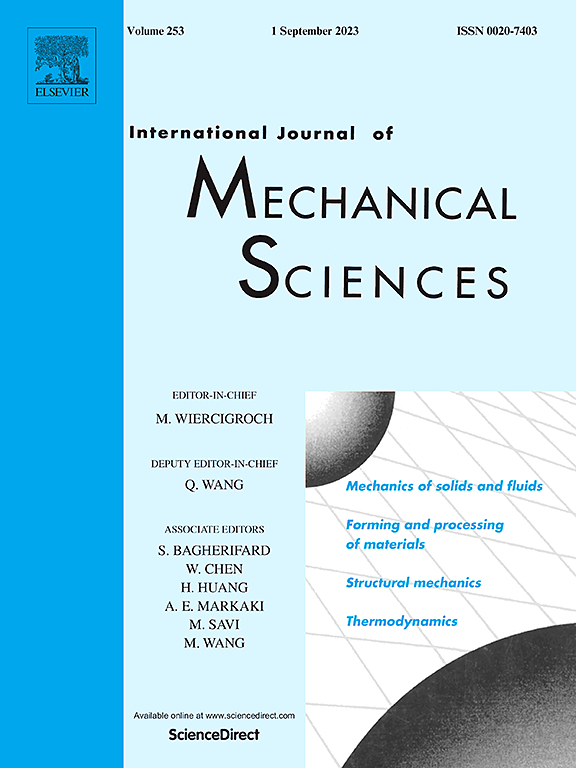Thermo-elasto-hydrodynamic analysis of gas foil bearings
IF 7.1
1区 工程技术
Q1 ENGINEERING, MECHANICAL
International Journal of Mechanical Sciences
Pub Date : 2025-02-01
DOI:10.1016/j.ijmecsci.2025.109940
引用次数: 0
Abstract
This paper proposes a comprehensive model for thermo-elasto-hydrodynamic analysis of gas foil bearings. In contrast to many works that simplify the foil structure to a two-dimensional model, the top foil and bump foil are modeled using the shell elements to consider the three-dimensional configuration and axial variation in deflection. To more accurately predict the heat transferred from the gas film to the bump foil, the subambient pressure is allowed and a contact model is developed to consider the nonlinear contact/separation behavior of foil structure. Emphasis is put on the thermal submodels of the gas film, rotor, foil structure and bearing sleeve, where the energy equation and heat equations are numerically solved using the finite element method. The global temperatures of the bearing system are simultaneously obtained using a fully coupled method, enabling a computationally efficient and robust solution. The results reveal that the temperature distribution of gas film exhibits fluctuations due to the contacts between the top and bump foils, but the subambient pressure also causes separations between the foils near the trailing region. Additionally, parametric studies are conducted to explore the effects of the rotational speed and nominal clearance on the thermal performance of foil bearings.

求助全文
约1分钟内获得全文
求助全文
来源期刊

International Journal of Mechanical Sciences
工程技术-工程:机械
CiteScore
12.80
自引率
17.80%
发文量
769
审稿时长
19 days
期刊介绍:
The International Journal of Mechanical Sciences (IJMS) serves as a global platform for the publication and dissemination of original research that contributes to a deeper scientific understanding of the fundamental disciplines within mechanical, civil, and material engineering.
The primary focus of IJMS is to showcase innovative and ground-breaking work that utilizes analytical and computational modeling techniques, such as Finite Element Method (FEM), Boundary Element Method (BEM), and mesh-free methods, among others. These modeling methods are applied to diverse fields including rigid-body mechanics (e.g., dynamics, vibration, stability), structural mechanics, metal forming, advanced materials (e.g., metals, composites, cellular, smart) behavior and applications, impact mechanics, strain localization, and other nonlinear effects (e.g., large deflections, plasticity, fracture).
Additionally, IJMS covers the realms of fluid mechanics (both external and internal flows), tribology, thermodynamics, and materials processing. These subjects collectively form the core of the journal's content.
In summary, IJMS provides a prestigious platform for researchers to present their original contributions, shedding light on analytical and computational modeling methods in various areas of mechanical engineering, as well as exploring the behavior and application of advanced materials, fluid mechanics, thermodynamics, and materials processing.
 求助内容:
求助内容: 应助结果提醒方式:
应助结果提醒方式:


